Integrating Digital Photogrammetry and 3D Laser Scanning into Service-Learning: The PATCULT 3D Project for Accessible Cultural Heritage
Abstract
1. Introduction
2. Materials and Methods
2.1. Overview of the Methodological Framework
2.2. Methodology
- Educational integration. The project is embedded transversally across several courses of the Degree in Geoinformation and Geomatics, ensuring that activities are aligned with the official learning outcomes of each subject. Students participate according to their academic level, from introductory topographic practices to advanced applications in drones, 3D modeling, and Final Degree Projects.
- Collaborative framework. The initiative is coordinated by a multidisciplinary teaching team, involving specialists in surveying, photogrammetry, 3D modeling, accessibility, and cultural heritage documentation. Additionally, the close collaboration with the ONCE (the Spanish National Organization of the Blind, Ávila office) ensures that the products meet accessibility standards and that the project maintains a direct social impact.
- Technical workflow. The project follows a structured workflow that begins with the selection of cultural heritage elements, considering their cultural relevance, technical feasibility, and potential accessibility for visually impaired users. Once selected, the assets are documented through data acquisition campaigns that combine terrestrial and aerial photogrammetry with high-resolution 3D laser scanning in the case of small artifacts. The digital data are subsequently processed, edited, and adapted in Blender v.4.2., ensuring that the resulting models meet tactile accessibility requirements by simplifying unnecessary details while preserving essential geometric features. To guide this adaptation, the teaching team worked with the recommendations provided by ONCE Ávila, which supplied the document “Technical Accessibility Criteria for Cultural and Natural Heritage for People with Visual Impairments” [39]. This reference served as a methodological framework throughout the project, offering practical guidelines on aspects such as the simplification of geometry, the use of textures to represent different materials, the appropriate scale for tactile exploration, and the inclusion of braille labels. These models are then materialized through 3D printing technologies, producing physical replicas designed for haptic exploration. The final outputs were subjected to a structured validation process involving visually impaired users in workshops coordinated with ONCE Ávila, thereby enabling the systematic collection of user-centered feedback on functional usability and accessibility performance. In parallel, the project also incorporates an educational evaluation phase: surveys are administered to the participating students and analyzed to assess both the acquisition of technical competences (photogrammetry, 3D modeling, and digital fabrication) and the development of transversal skills such as teamwork, empathy, and social responsibility.
2.3. Educational Framework and Participants
2.4. Selection of Cultural Heritage Elements
- Cultural relevance. Priority was given to elements representative of the cultural identity of the region of Ávila, encompassing both monumental architecture and movable heritage of historical and artistic value. The inclusion of a variety of typologies (sculptures, architectural elements and archeological remains) aimed to reflect the richness and diversity of the local heritage.
- Technical feasibility. The assets were selected according to their size, material, state of conservation, and accessibility for data acquisition. Elements suitable for terrestrial and aerial photogrammetry were combined with smaller objects that could be documented through high-resolution 3D scanning, ensuring that students were exposed to a wide range of geomatic techniques.
- Accessibility potential. Special consideration was given to the suitability of the assets for tactile interpretation by visually impaired users. This required choosing elements with well-defined shapes, reliefs, or symbolic value that could be effectively reproduced in 3D-printed replicas without losing their legibility through touch.
- -
- Figure 2(1): Statue of San Segundo (Hermitage of San Segundo, Ávila). A devotional sculpture located in the Hermitage of San Segundo, dedicated to the patron saint of Ávila. It is one of the most important cult images in the city and a key symbol of local identity (the data was collected on site) [40].
- -
- Figure 2(2): Aunqueospese Castle (Mironcillo). A 15th-century fortress and one of the best-preserved examples of late medieval military architecture in Ávila. Its keep, walls, and barbican illustrate defensive strategies of the time, and its prominent location makes it a landmark in the provincial landscape (the data was collected on site) [41].
- -
- Figure 2(3): Ritual Sauna and Rock Sanctuary, Ulaca oppidum (Solosancho). One of the most relevant archeological sites of the Iberian Peninsula during pre-Roman times. The sauna, carved into the rock, is interpreted as a ritual space, while the sanctuary may have been used for sacrifices (the data was collected on site) [42,43].
- -
- -
- -
- -
- -
- Figure 2(8): Arenas de San Pedro Castle (Arenas de San Pedro). Also known as the Castle of Don Álvaro de Luna, this 15th-century fortress preserves cylindrical towers and a strong walled enclosure, making it a fine example of late Gothic military architecture (the data collection was carried out on a replica) [49].
- -
- -
2.5. Data Acquisition and Processing
2.5.1. Terrestrial Photogrammetry
2.5.2. Aerial Photogrammetry with UAVs
2.5.3. Micro-Photogrammetry
2.5.4. Image Processing Workflow with Photogrammetric Software
2.5.5. High-Resolution 3D Scanning
2.5.6. Accessibility Guidelines
2.5.7. Student Survey
3. Results
4. Discussion
5. Conclusions
Supplementary Materials
Author Contributions
Funding
Institutional Review Board Statement
Informed Consent Statement
Data Availability Statement
Acknowledgments
Conflicts of Interest
References
- Li, H.; Ikebe, K.; Kinoshita, T.; Chen, J.; Su, D.; Xie, J. How heritage promotes social cohesion: An urban survey from Nara city, Japan. Cities 2024, 149, 104985. [Google Scholar] [CrossRef]
- Richardson, M.; Butler, C.W.; Alcock, I.; Tindley, A.; Sheffield, D.; White, P.C. Introducing heritage connectedness: Connections to people, nature and place across time are associated with wellbeing and environmentalism. Hist. Environ. Policy Pract. 2025, 16, 38–58. [Google Scholar] [CrossRef]
- Naheed, S.; Shooshtarian, S. The role of cultural heritage in promoting urban sustainability: A brief review. Land 2022, 11, 1508. [Google Scholar] [CrossRef]
- Maté-González, M.Á.; Sáez Blázquez, C.; Gutiérrez-Martín, N.; Lorenzo Canales, M. Evaluation of the Emotional Impacts of the Notre Dame Cathedral Fire and Restoration on a Population Sample. Heritage 2025, 8, 226. [Google Scholar] [CrossRef]
- Chen, W. Social cohesion from urban heritage. Nat. Cities 2024, 1, 496. [Google Scholar] [CrossRef]
- Mastrogiuseppe, M.; Span, S.; Bortolotti, E. Improving accessibility to cultural heritage for people with intellectual disabilities: A tool for observing the obstacles and facilitators for the access to knowledge. ALTER Eur. J. Disabil. Res. 2021, 15, 113–123. [Google Scholar] [CrossRef]
- Álvarez-Couto, M.; Sáez-Suanes, G.P.; Mena, M.S.; Díaz, C.P. Patrimonio cultural, accesibilidad cognitiva y discapacidad intelectual|Cultural heritage, cognitive accessibility and intellectual disabilities. Rev. Esp. Discapacidad 2025, 13, 159–172. [Google Scholar] [CrossRef]
- UNESCO. Accessibility and Inclusion are Key to Building a Fairer, More Sustainable World. Available online: https://www.unesco.org/en/articles/accessibility-and-inclusion-are-key-building-fairer-more-sustainable-world (accessed on 6 November 2025).
- del Bosque, A.; Fernández-Arias, P.; Castro-López, P.; Nieto-Sobrino, M.; Vergara, D. Universal Accessibility to Cultural Heritage in Spain: A Bibliometric Review. Buildings 2025, 15, 1563. [Google Scholar] [CrossRef]
- Zhang, Y.; Ikiz Kaya, D.; van Wesemael, P.; Colenbrander, B.J. Youth participation in cultural heritage management: A conceptual framework. Int. J. Herit. Stud. 2024, 30, 56–80. [Google Scholar] [CrossRef]
- Singh, A.; Singh, P.; Saraswat, V.; Pushparajesh, V.; Goyal, S.; Zaveri, B.; Reddy, B. Examining the Impact of Young People’s Involvement in Cultural Heritage Preservation and Promotion. Evol. Stud. Imaginative Cult. 2024. submitted. [Google Scholar]
- Kasemsarn, K.; Nickpour, F. Digital Storytelling in Cultural and Heritage Tourism: A Review of Social Media Integration and Youth Engagement Frameworks. Heritage 2025, 8, 200. [Google Scholar] [CrossRef]
- Perrotti, C.; Longo, N.V.; Plaut, J.L.; Bush, A. Learning through Collaboration: Reflections on Cultivating Cross-Institutional Capacity for Place-Based Community Engagement. Metrop. Univ. 2024, 35, 85–106. [Google Scholar] [CrossRef] [PubMed]
- Kaliappen, N. Applying Community-Engaged Service Learning to Enhance Students’ Knowledge, Civic Engagement and Social Responsibility. AIB Insights 2025, 25, 1–7. [Google Scholar] [CrossRef]
- Hooli, E.M.; Corral-Robles, S.; Ortega-Martín, J.L.; Baena-Extremera, A.; Ruiz-Montero, P.J. The impact of service learning on academic, professional and physical wellbeing competences of EFL teacher education students. Int. J. Environ. Res. Public Health 2023, 20, 4852. [Google Scholar] [CrossRef]
- Khiatani, P.V.; She, M.H.C.; Ho, O.Y.Y.; Liu, J.K.K. Service-learning under COVID-19: A scoping review of the challenges and opportunities for practicing service-learning in the ‘New Normal’. Int. J. Educ. Dev. 2023, 100, 102813. [Google Scholar] [CrossRef]
- Brand, B.D.; Brascia, K.; Sass, M. The community outreach model of service-learning: A case study of active learning and service-learning in a natural hazards, vulnerability, and risk class. High. Learn. Res. Commun. 2019, 9. [Google Scholar] [CrossRef]
- Pérez-Baena, M.J.; Cordero-Pérez, F.J.; Holgado-Madruga, M. Implementing the service-learning methodology in nursing education: A case study. Nurse Educ. Today 2025, 144, 106449. [Google Scholar] [CrossRef]
- Kistler, A. Learning Anthropology by Teaching Anthropology: A Case Study of Five Service-Learning Classes at Rollins College. J. Community Engagem. Scholarsh. 2022, 13, 88–98. [Google Scholar] [CrossRef]
- Álvarez-Vanegas, A.; Ramani, S.V.; Volante, L. Service-Learning as a niche innovation in higher education for sustainability. Front. Educ. 2024, 9, 1291669. [Google Scholar] [CrossRef]
- Mahmud, S.N.D.; Ismail, N.K. STEM service learning in higher education: A systematic literature review. Eurasia J. Math. Sci. Technol. Educ. 2024, 20, em2549. [Google Scholar] [CrossRef]
- Aktürk, G.; Hauser, S.J. Integrated understanding of climate change and disaster risk for building resilience of cultural heritage sites. Nat. Hazards 2025, 121, 4309–4334. [Google Scholar] [CrossRef]
- Blavier, C.L.S.; Huerto-Cardenas, H.E.; Aste, N.; Del Pero, C.; Leonforte, F.; Della Torre, S. Adaptive measures for preserving heritage buildings in the face of climate change: A review. Build. Environ. 2023, 245, 110832. [Google Scholar] [CrossRef]
- Dimabayao, J.J.; Lara, J.L.; Canoura, L.G.; Solheim, S. Integrating climate risk in cultural heritage: A critical review of assessment frameworks. Heritage 2025, 8, 312. [Google Scholar] [CrossRef]
- Roggio, D.S.; Shokrollahi, S.; Forte, A.; Bitelli, G. Exploring Historical Changes to Architectural Heritage Through Reality-Based 3D Modeling and Virtual Reality: A Case Study. ISPRS Int. J. Geo-Inf. 2025, 14, 353. [Google Scholar] [CrossRef]
- Rigamonti, M.; Augelli, F. Innovating Architectural Preservation and Adaptive Reuse Design Education in Hunan: The Digital Turn from hBIM Modelling to Digital Replicas. In Cultural Heritage Preservation for Vulnerable Territories: The Hunan Province in China; Springer Nature: Cham, Switzerland, 2024; pp. 303–318. [Google Scholar]
- Maté-González, M.Á.; Rodríguez-Hernández, J.; Sáez Blázquez, C.; Troitiño Torralba, L.; Sánchez-Aparicio, L.J.; Fernández Hernández, J.; Herrero Tejedor, T.R.; Fabián García, J.F.; Piras, M.; Díaz-Sánchez, C.; et al. Challenges and Possibilities of Archaeological Sites Virtual Tours: The Ulaca Oppidum (Central Spain) as a Case Study. Remote Sens. 2022, 14, 524. [Google Scholar] [CrossRef]
- Herrero-Tejedor, T.R.; Maté-González, M.Á.; Pérez-Martín, E.; López-Cuervo, S.; López de Herrera, J.; Sánchez-Aparicio, L.J.; Villanueva Llauradó, P. Documentation and Virtualisation of Vernacular Cultural Heritage: The Case of Underground Wine Cellars in Atauta (Soria). Heritage 2023, 6, 5130–5150. [Google Scholar] [CrossRef]
- Maté-González, M.Á.; Sáez Blázquez, C.; Rodríguez-Hernández, J.; Álvarez-Sanchís, J.R.; López-Cuervo Medina, S. Unveiling history: An innovative approach to the dissemination of archaeological heritage. Digit. Appl. Archaeol. Cult. Herit. 2025, 39, e00467. [Google Scholar] [CrossRef]
- Díaz-Navarro, S.; Sánchez De La Parra-Pérez, S. Human evolution in your hands. Inclusive education with 3D-printed typhological replicas. J. Biol. Educ. 2021, 57, 295–307. [Google Scholar] [CrossRef]
- Maté-González, M.Á.; Sáez Blázquez, C.; Rodríguez-Hernández, J.; Álvarez-Sanchís, J.R. A Proposal for Innovative Higher Education in Archaeology Through the Use of Virtual Tours. In Proceedings of the TEEM 2022: International Conference on Technological Ecosystems for Enhancing Multiculturality, Salamanca, Spain, 19–21 October 2022; García-Peñalvo, F.J., García-Holgado, A., Eds.; Springer: Singapore, 2023; pp. 1053–1061. [Google Scholar] [CrossRef]
- De-Miguel-Sánchez, M.; Gutiérrez-Pérez, N. A methodology to make cultural heritage more accessible to people with visual disabilities through 3D printing. DisegnareCon 2024, 17, 41–411. [Google Scholar] [CrossRef]
- Chapinal-Heras, D.; Díaz-Sánchez, C.; Gómez-García, N.; España-Chamorro, S.; Pagola-Sánchez, L.; Parada López de Corselas, M.; Elías Rey-Álvarez Zafiria, M. Photogrammetry, 3D modelling and printing: The creation of a collection of archaeological and epigraphical materials at the university. Digit. Appl. Archaeol. Cult. Herit. 2024, 33, e00341. [Google Scholar] [CrossRef]
- Remondino, F.; Spera, M.G.; Nocerino, E.; Menna, F.; Nex, F. State of the Art in High Density Image Matching. Photogramm. Rec. 2014, 29, 144–166. [Google Scholar] [CrossRef]
- Stylianidis, E.; Remondino, F. (Eds.) 3D Recording, Documentation and Management of Cultural Heritage; Whittles Publishing: Dunbeath, UK, 2016. [Google Scholar]
- Guidi, G.; Russo, M.; Angheleddu, D. 3D Survey and Virtual Reconstruction of Archaeological Sites. Digit. Appl. Archaeol. Cult. Herit. 2014, 1, 55–69. [Google Scholar]
- Barzaghi, S.; Bordignon, A.; Collina, F.; Fabbri, F.; Fanini, B.; Ferdani, D.; Sullini, M. A Reproducible Workflow for the Creation of Digital Twins in the Cultural Heritage Domain. Transformations 2025, 1, 1–62. [Google Scholar]
- Maté-González, M.Á.; Aramendi, J.; Sáez-Blázquez, C.; Arriaza, M.C.; Yravedra, J. Synergies Between Geomatics and Biological Sciences for the Creation of New Virtual Materials for Teaching Taphonomy. In Proceedings of the International Conference on Technological Ecosystems for Enhancing Multiculturality (TEEM 2022), Salamanca, Spain, 19–21 October 2022; Springer Nature Singapore: Singapore, 2022; pp. 1072–1081. [Google Scholar]
- Hermida Simil, G. Criterios Técnicos de Accesibilidad al Patrimonio Cultural y Natural Para Personas Con Discapacidad Visual. Available online: http://riberdis.cedid.es/handle/11181/6223 (accessed on 6 November 2025).
- Ferrer García, F.A. La Invención de la Iglesia de San Segundo. Cofrades y Frailes Abulenses en Los Siglos XVI y XVII, Excma; Diputación Provincial de Ávila–Institución “Gran Duque de Alba”: Ávila, Spain, 2006. [Google Scholar]
- Bernard Remón, J. Castillos de Segovia y Ávila; Ediciones Lancia: León, Spain, 1990. [Google Scholar]
- Álvarez-Sanchís, J.R. Oppida and Celtic society in western Spain. e-Keltoi 2005, 6, 255–285. [Google Scholar]
- Ruiz Zapatero, G. Castro de Ulaca. Solosancho, Ávila; Institución Gran Duque de Alba: Ávila, Spain, 2005. [Google Scholar]
- Maté-González, M.Á.; Yali, R.; Rodríguez-Hernández, J.; González-González, E.; Aguirre de Mata, J. Comparison of NeRF- and SfM-Based Methods for Point Cloud Reconstruction for Small-Sized Archaeological Artifacts. Remote Sens. 2025, 17, 2535. [Google Scholar] [CrossRef]
- Álvarez-Sanchís, J.R.; Rodríguez-Hernández, J.; Ruiz Zapatero, G. El askos de Ulaca (Solosancho, Ávila) y el simbolismo del toro entre los vettones. Trab. Prehist. 2021, 78, 356–365. [Google Scholar] [CrossRef]
- Álvarez-Sanchís, J.R. Zoomorphic Iron Age Sculpture in Western Iberia: Symbols of Social and Cultural Identity? Proc. Prehist. Soc. 1994, 60, 403–416. [Google Scholar] [CrossRef]
- Gutiérrez Robledo, J.L. Las Murallas de Ávila. Arquitectura e Historia; Diputación de Ávila–Institución Gran Duque de Alba: Ávila, Spain, 2009. [Google Scholar]
- Ríos Almarza, A. Apuntes de Ávila. Sugerencias Para Una Visita; Ayuntamiento de Ávila: Ávila, Spain, 2007. [Google Scholar]
- Tejero Robledo, E. El Castillo Del “Condestable Dávalos” de Arenas de San Pedro (Ávila): En la Ciudad del Valle del Tiétar; Crea Impresión 2000: Madrid, Spain, 2007. [Google Scholar]
- Fabián, J.F.; Gimeno, H.; Hernando, M.D.; Pires, H. The ‘Toros de Guisando’ in the Digital Age. In Epigraphy in the Digital Age: Opportunities and Challenges in the Recording, Analysis and Dissemination of Inscriptions; Velázquez, I., Espinosa, D., Eds.; Archaeopress: Oxford, UK, 2021; pp. 91–114. [Google Scholar]
- Cabo Alonso, Á.; Gutiérrez Robledo, J.L.; Martín Rodríguez, J.L.; Pérez Puigjané, M. El castillo de Arévalo; Lunwerg–Ministerio de Agricultura, Pesca y Alimentación: Madrid, Spain, 1988. [Google Scholar]
- González-Aguilera, D.; López-Fernández, L.; Rodríguez-González, P.; Guerrero-Sevilla, D.; Hernández-López, D.; Menna, F.; Nocerino, E.; Toschi, I.; Remondino, F.; Ballabeni, A.; et al. Development of an All-Purpose Free Photogrammetric Tool. Int. Arch. Photogramm. Remote Sens. Spatial Inf. Sci. 2016, 41, 31–38. [Google Scholar] [CrossRef]
- González-Aguilera, D.; López-Fernández, L.; Rodríguez-Gonzálvez, P.; Hernández-López, D.; Guerrero, D.; Remondino, F.; Menna, F.; Nocerino, E.; Toschi, I.; Ballabeni, A.; et al. GRAPHOS–Open-Source Software for Photogrammetric Applications. Photogramm. Rec. 2018, 33, 11–29. [Google Scholar]
- Timpson, C. Inclusive design and accessibility: A methodology of perpetual evolution and innovation. In The Museum Accessibility Spectrum; Routledge: London, UK, 2025; pp. 209–227. [Google Scholar]
- Metatla, O.; Bryan-Kinns, N.; Stockman, T.; Martin, F. Designing with and for people living with visual impairments: Audio-tactile mock-ups, audio diaries and participatory prototyping. CoDesign 2015, 11, 35–48. [Google Scholar]
- Lucchi, E. Digital twins, artificial intelligence and immersive technologies for heritage preservation and cultural tourism in smart cities. In Digital Twin, Blockchain, and Sensor Networks in the Healthy and Mobile City; Elsevier: Amsterdam, The Netherlands, 2025; pp. 507–520. [Google Scholar]
- Giliberto, F.; Labadi, S. Harnessing cultural heritage for sustainable development: An analysis of three internationally funded projects in MENA countries. Int. J. Herit. Stud. 2022, 28, 133–146. [Google Scholar] [CrossRef]
- Antón, D.; Amaro-Mellado, J.L.; Rico-Delgado, F.; Díaz-Cañete, P. Exploring the accessibility of deformed digital heritage models. Diagn. Herit. Build. By Non-Destr. Tech. 2024, 275–302. [Google Scholar]
- Rattanarungrot, S.; White, M.; Chairungsee, S. Enhancing Cultural Heritage Accessibility Through Three-Dimensional Artifact Visualization on Web-Based Open Frameworks. Informatics 2025, 12, 37. [Google Scholar] [CrossRef]
- Buragohain, D.; Meng, Y.; Deng, C.; Li, Q.; Chaudhary, S. Digitalizing cultural heritage through metaverse applications: Challenges, opportunities, and strategies. Herit. Sci. 2024, 12, 295. [Google Scholar] [CrossRef]

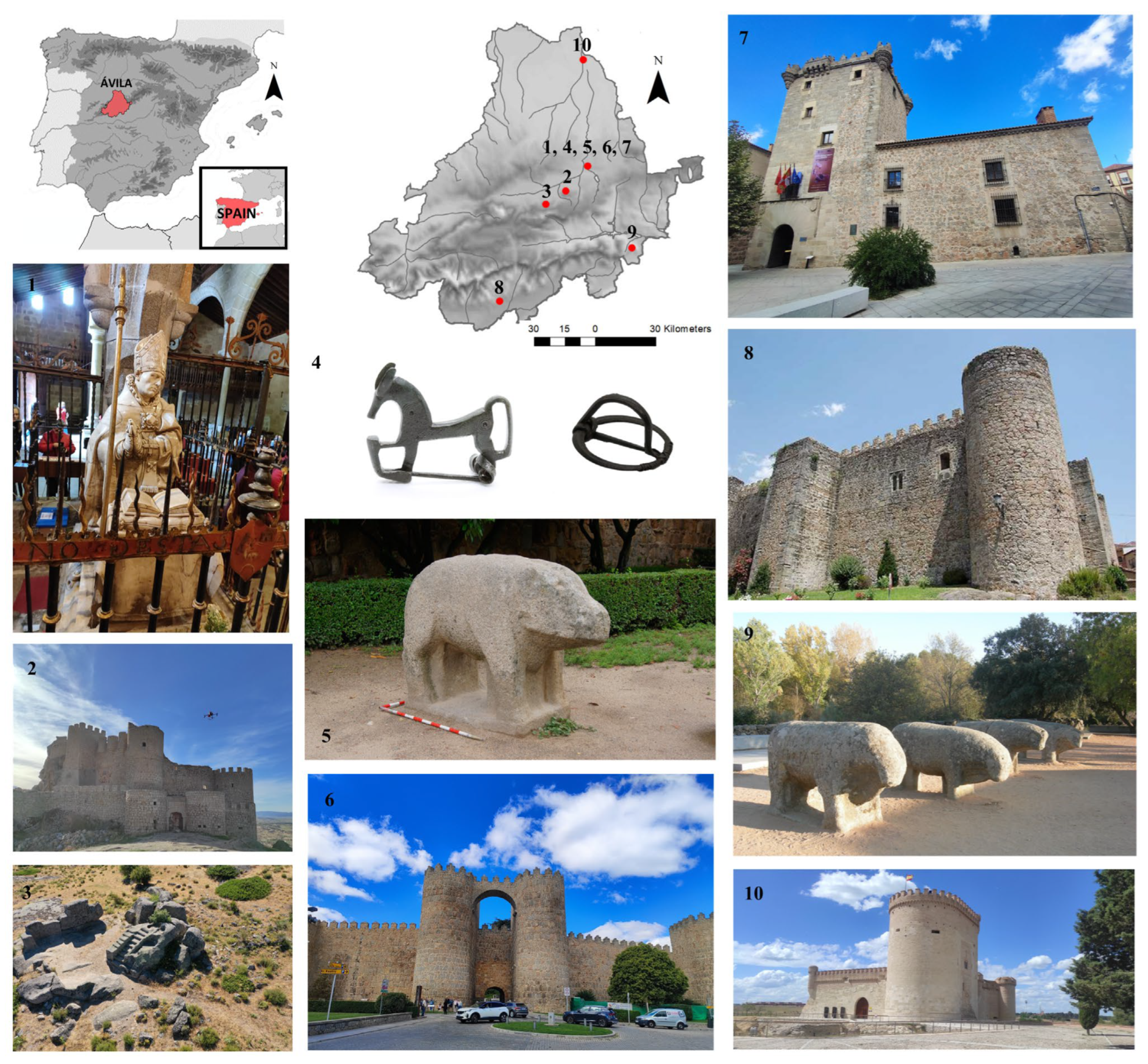
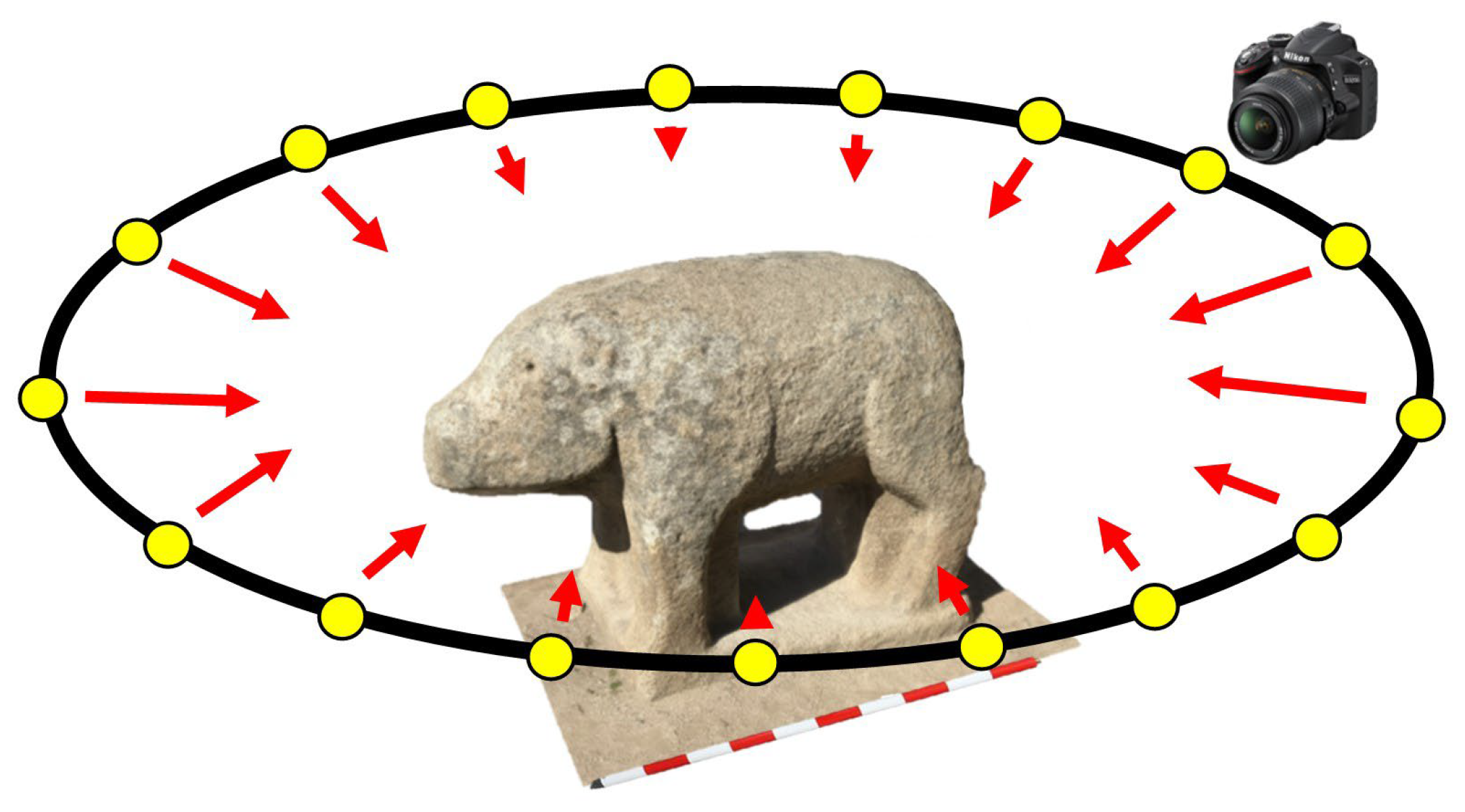

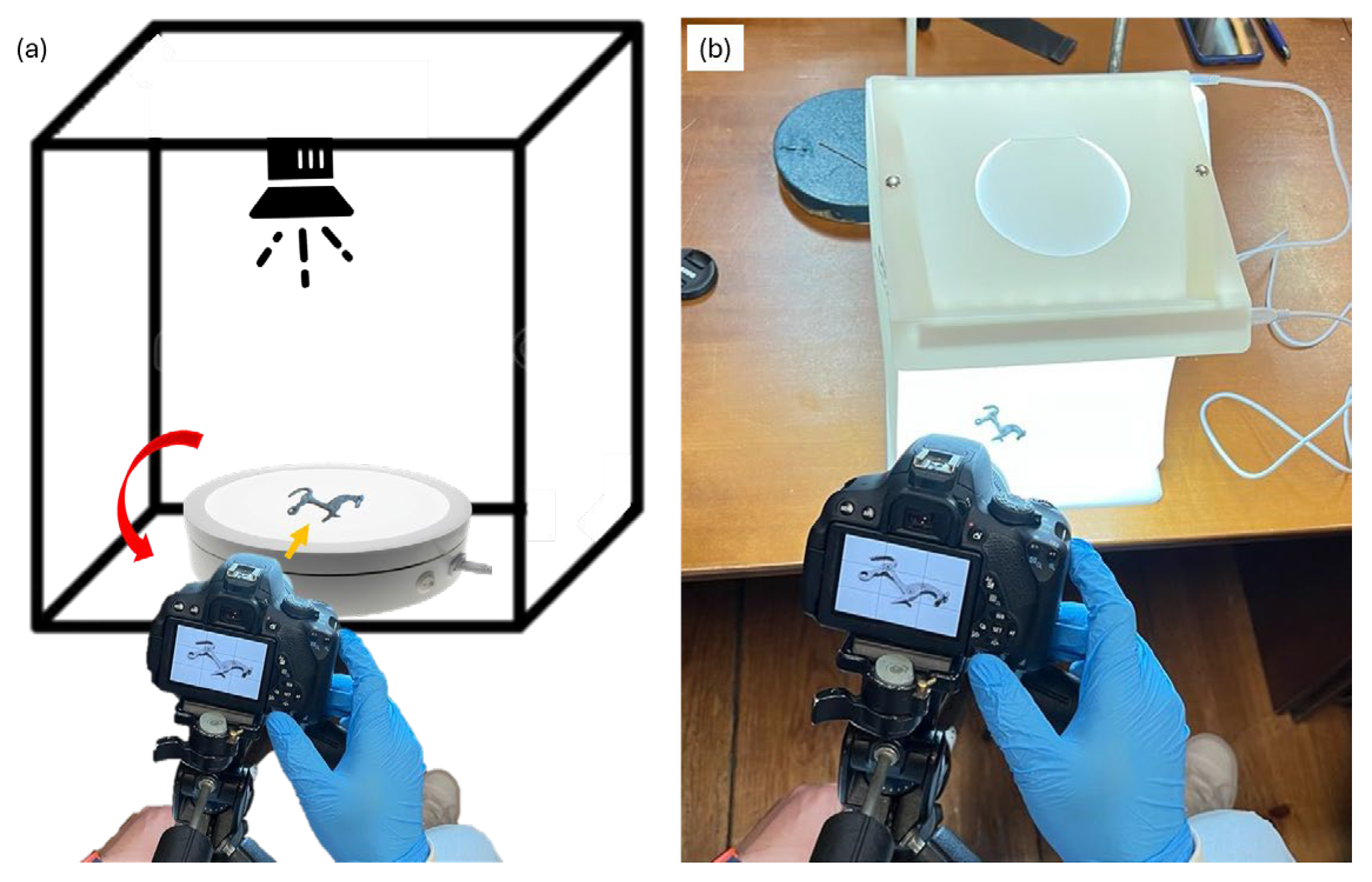
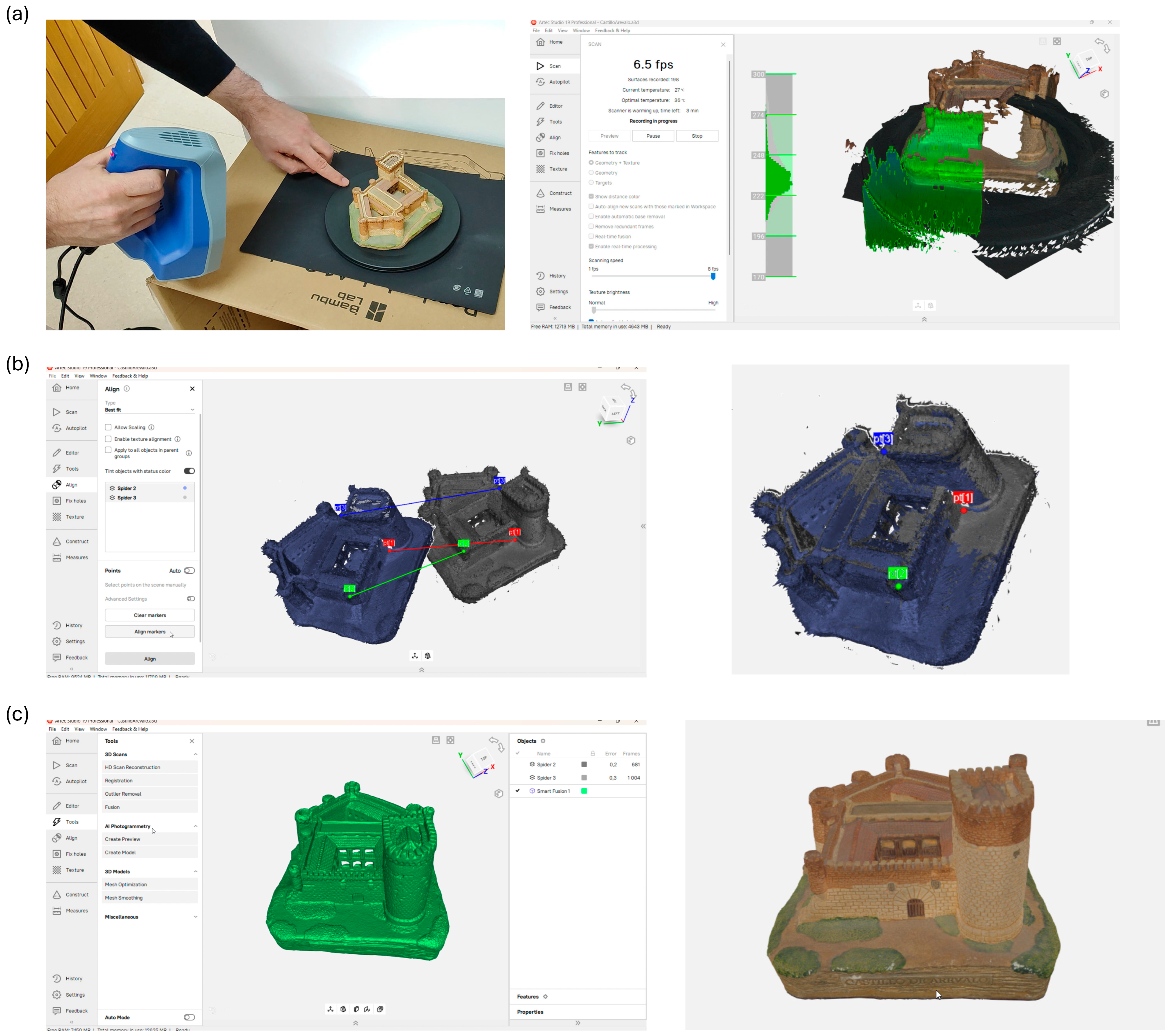

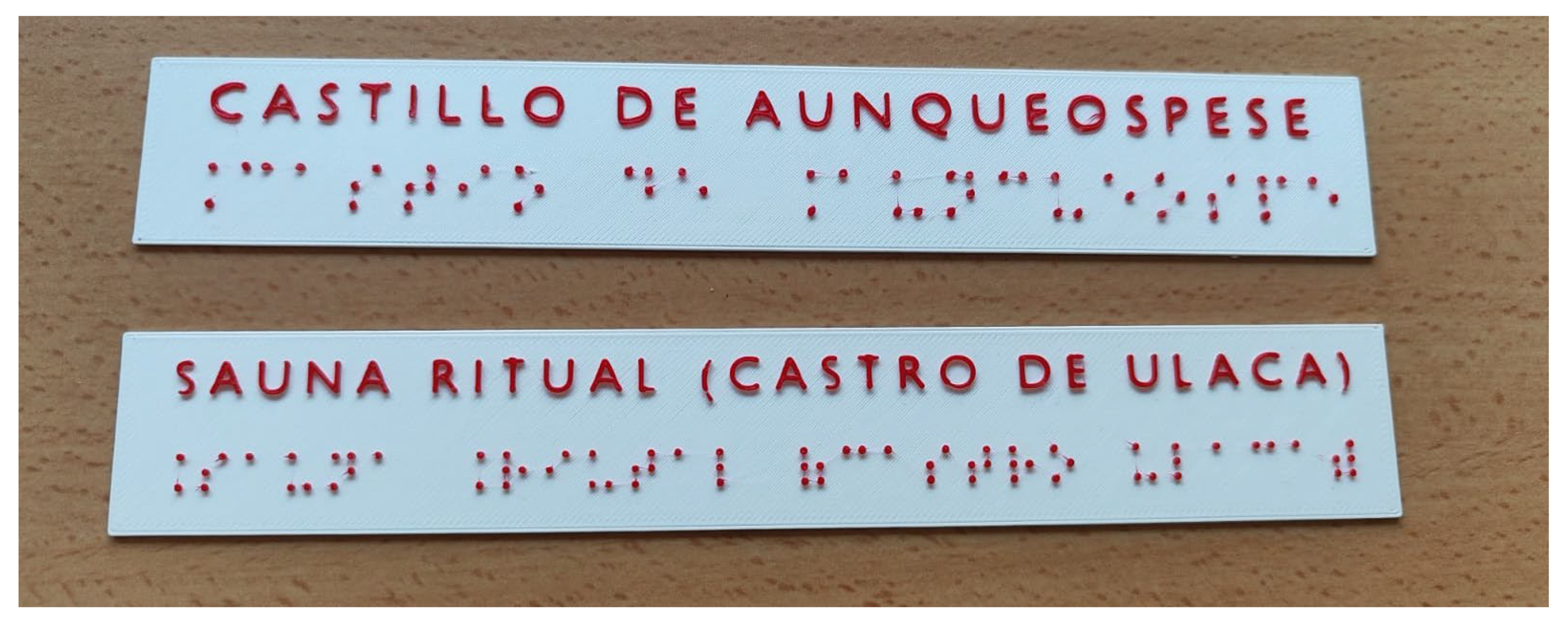
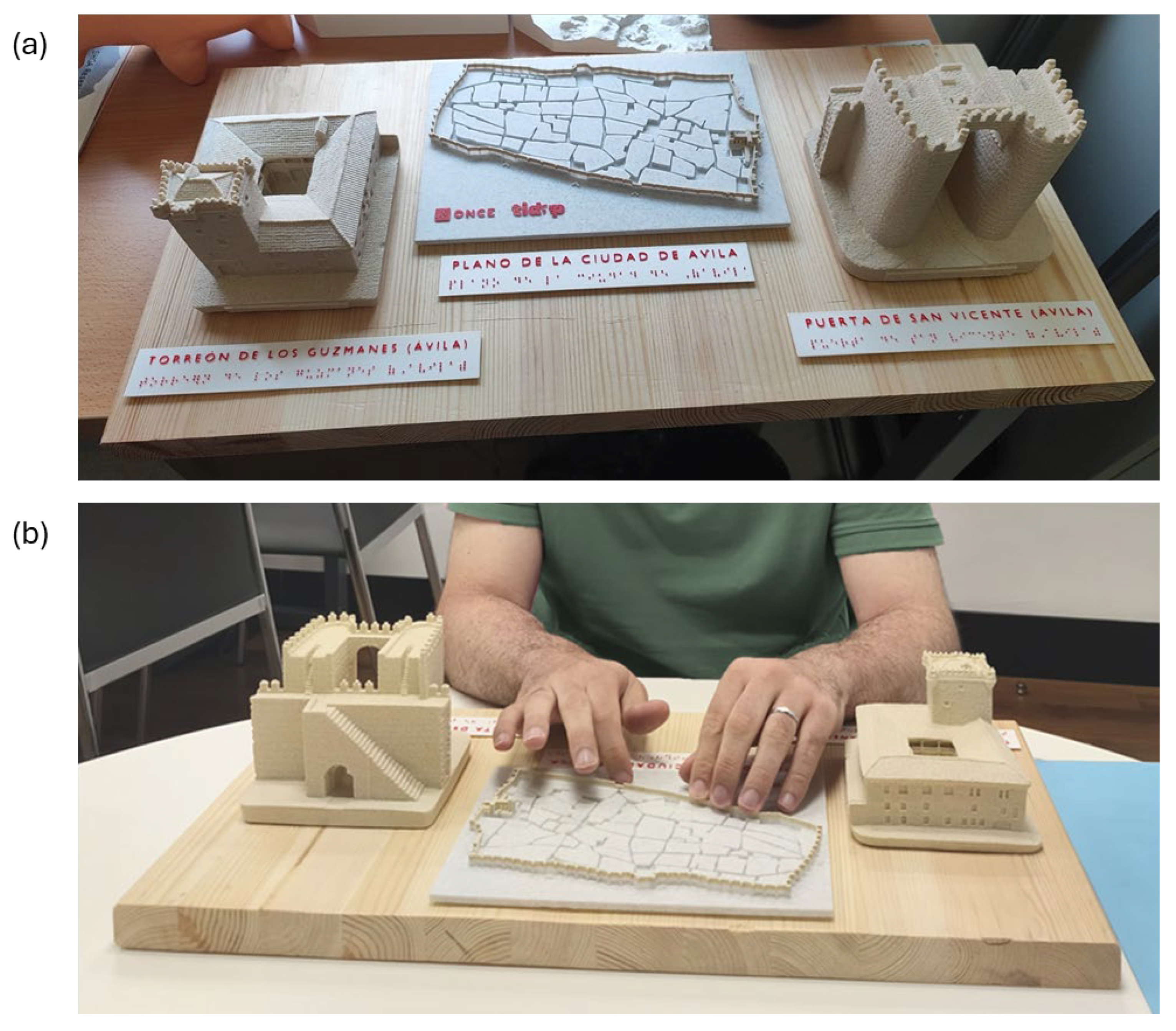
| Instrument | Model | Key Specifications | Use |
|---|---|---|---|
| Digital Single Lens Reflex (DSLR) Camera | Canon EOS 700D + Canon EF-S 60 mm f/2.8 Macro (Canon Inc., Ōta-ku, Tokyo, Japan) | 18 MP APS-C sensor; max. resolution 5184 × 3456 px; fixed focal macro lens; high sharpness for close-range work | Micro-photogrammetry of small artifacts |
| DSLR Camera | Nikon D5600 + AF-P 18–55 mm (Nikon Corporation, Tokyo, Japan) | 24.2 MP APS-C sensor; max. resolution 6000 × 4000 px; variable focal length (used at fixed focal values); high portability | Terrestrial photogrammetry of medium-scale elements |
| UAV | DJI Mavic 2 Pro/DJI Matrice 350 RTK (SZ DJI Technology Co., Ltd., Shenzhen, China) | 20 MP 1” CMOS Hasselblad sensor; mechanical shutter; accuracy: ±0.1 m (vertical), ±0.3 m (horizontal)/20 MP RGB sensor (Zenmuse P1); RTK positioning accuracy ±0.1 m (vertical), ±0.3 m (horizontal); mechanical shutter | Aerial photogrammetry |
| 3D Scanner | Artec Eva (Artec 3D, Senningerberg, Luxembourg) | Accuracy up to 0.1 mm; 3D resolution 0.5 mm; working distance 0.4–1.0 m | Medium-size objects (sculptures, architectural fragments) |
| 3D Scanner | Artec Spider (Artec 3D, Senningerberg, Luxembourg) | Accuracy up to 0.05 mm; 3D resolution 0.1 mm; working distance 0.17–0.35 m | Small objects with fine morphological detail |
| Photogrammetry Software | GRAPHOS v.2.0.0.beta.8 | Complete SfM–MVS pipeline; SIFT-based feature extraction; GNSS-assisted matching; dense cloud + mesh + texture generation; open-source | Processing of terrestrial, aerial, and micro-photogrammetry datasets |
| 3D Scanning Software | Artec Studio v.19.2.4.8 | Real-time alignment; global registration (ICP); Sharp Fusion mesh creation; advanced texture mapping; scale and accuracy control | Processing and fusion of structured-light scanning datasets |
| Category | Item (Shortened) | Mean | SD |
|---|---|---|---|
| Photogrammetry & Data Acquisition Skills | DSLR acquisition protocols | 4.5 | 0.5 |
| UAV Mission Planning & Aerial Workflows | UAV mission planning | 4.3 | 0.6 |
| 3D Scanning & Structured-Light Processing | Artec Eva/Spider operation | 4.2 | 0.7 |
| Accessibility-Oriented 3D Editing (Blender) | Model optimization | 4.6 | 0.5 |
| Learning Process & Instructional Clarity | Clarity of instructions | 4.7 | 0.4 |
| Accessibility Awareness & Social Impact Perception | Value of accessibility | 4.4 | 0.6 |
| Overall Satisfaction with the PATCULT 3D Experience | Overall satisfaction | 4.6 | 0.5 |
Disclaimer/Publisher’s Note: The statements, opinions and data contained in all publications are solely those of the individual author(s) and contributor(s) and not of MDPI and/or the editor(s). MDPI and/or the editor(s) disclaim responsibility for any injury to people or property resulting from any ideas, methods, instructions or products referred to in the content. |
© 2025 by the authors. Licensee MDPI, Basel, Switzerland. This article is an open access article distributed under the terms and conditions of the Creative Commons Attribution (CC BY) license (https://creativecommons.org/licenses/by/4.0/).
Share and Cite
Maté-González, M.Á.; González González, E.; Sáez Blázquez, C.; Peral Fernández, F.; Andrés-Anaya, P.; Díaz-de la Fuente, S.; Arias-Pérez, B.; López-Cuervo Medina, S.; Rodríguez-Hernández, J. Integrating Digital Photogrammetry and 3D Laser Scanning into Service-Learning: The PATCULT 3D Project for Accessible Cultural Heritage. Appl. Sci. 2025, 15, 12425. https://doi.org/10.3390/app152312425
Maté-González MÁ, González González E, Sáez Blázquez C, Peral Fernández F, Andrés-Anaya P, Díaz-de la Fuente S, Arias-Pérez B, López-Cuervo Medina S, Rodríguez-Hernández J. Integrating Digital Photogrammetry and 3D Laser Scanning into Service-Learning: The PATCULT 3D Project for Accessible Cultural Heritage. Applied Sciences. 2025; 15(23):12425. https://doi.org/10.3390/app152312425
Chicago/Turabian StyleMaté-González, Miguel Ángel, Enrique González González, Cristina Sáez Blázquez, Fernando Peral Fernández, Paula Andrés-Anaya, Silvia Díaz-de la Fuente, Benjamín Arias-Pérez, Serafín López-Cuervo Medina, and Jesús Rodríguez-Hernández. 2025. "Integrating Digital Photogrammetry and 3D Laser Scanning into Service-Learning: The PATCULT 3D Project for Accessible Cultural Heritage" Applied Sciences 15, no. 23: 12425. https://doi.org/10.3390/app152312425
APA StyleMaté-González, M. Á., González González, E., Sáez Blázquez, C., Peral Fernández, F., Andrés-Anaya, P., Díaz-de la Fuente, S., Arias-Pérez, B., López-Cuervo Medina, S., & Rodríguez-Hernández, J. (2025). Integrating Digital Photogrammetry and 3D Laser Scanning into Service-Learning: The PATCULT 3D Project for Accessible Cultural Heritage. Applied Sciences, 15(23), 12425. https://doi.org/10.3390/app152312425








